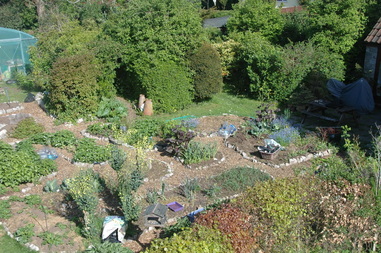 The permaculture vegetable plot in Gorge View Garden
The permaculture vegetable plot in Gorge View Garden
Guests are welcome to explore the Gorge View Garden, another asset of Gorge View Cottage, with beautiful views to Cheddar Gorge. Our gardening ethos is to co-create with nature, maximising biodiversity and habitats for wildlife, whilst growing as much of our own produce as possible. The garden is alive and abundant, and a beautiful place in which to experience and connect with nature.
A brief history of the garden
When we bought Gorge View in 2003, the garden was mainly grass and very overgrown shrubs and Leylandii which took a lot of light. For the first 2 years we did very little, other than watching the garden through the seasons, getting to know and understand the land and what was growing, and removing the obvious invasive weeds such as brambles and bindweed. Being novice gardeners, particularly with anything other than growing simple vegetables, this observation through the seasons gave us the chance to learn from the garden.
Then began the process over the next couple of years of tending to the overgrown shrubs, and cutting down the Leylandii, which gave some lovely surprises as plants we never knew existed in the garden took the opportunity of the increased light to flourish. A good shredder is one of the best things we've bought for the garden, enabling us to shred all garden waste on site for making compost and using as mulch to keep weeds down. Making compost and leaf mould is an excellent way to start improving soil structure and health. ‘Feed the soil, and it will feed you’.
Understanding the many individual and environmental benefits of home grown produce ,we tentatively started small scale organic veggie growing in pots and a raised bed made of reclaimed railway sleepers on the patio. We also installed water butts at every available point, and finally a rainwater harvesting system during the renovation of the cottage. We planted some native trees such as silver birch, holly, oak, and allowed several self-seeded hazel, and ash to grow in appropriate areas to coppice for our wood burner, and to make bean poles, and other useful structures in the garden. We have always fed the wild birds, and the bird population and varieties have noticeable increased during our time here.
We also sunk an old washing up bowl into a corner of the garden, and were delighted to discover frog-spawn in it the following spring. This encouraged us to create a proper wildlife pond. One of the many advantages of wildlife ponds is that they encourage a range of insects, which attract more birds, having a positive knock-on effect for increasing biodiversity.Another advantage is attracting frogs, which eat slugs, therefore very useful for chemical-free gardening.
Inspired and encouraged by attending a permaculture course run by Patrick Whitefield, and attending a seminar by Charles Dowding, we are using permaculture philosophy and organic gardening principles and for planning and managing land use. The ‘lawn’ closest to the house has been converted into a vegetable plot , and with increasing success and confidence in growing our own in a way that is wildlife friendly and looks attractive, more of the garden has steadily been converted to productivity. We create manageable sized raised beds for the veggie growing, making use of what is on the land, such as rocks for edging, paths and walls, rather than buying stuff in. With permaculture planning in mind, the veggie beds evolved into attractive curved shapes, maximising growing area, and incorporating ease of access to the rest of the garden. (People don't tend to naturally walk around in a grid shape.) In 2008 we installed a polytunnel to extend the growing seasons.
For the last 3 years we have been concentrating on planting fruit trees and creating soft fruit areas, as well as reducing the amount of 'lawn', by planting nectar and pollen rich plants and shrubs to provide support for wildlife throughout the year. We also leave areas of grass long as another wildlife habitat, which has the added advantage of less grass to cut. This winter (2013) we plan to create a larger wildlife pond, and begin to record the increasingly abundant flora and fauna that is resident in, or visits our garden. We welcome out guests to let us know what wildlife they've seen, or fill in the nature diary in the cottage.
Take a look at our blog for further updates about the progress of the garden.

